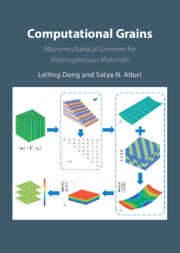Refine search
Actions for selected content:
106069 results in Materials Science
9 - Computational Grains for Viscoelastic Composites
-
- Book:
- Computational Grains
- Published online:
- 05 October 2023
- Print publication:
- 19 October 2023, pp 168-191
-
- Chapter
- Export citation
3 - Direct Numerical Simulation of Materials Using Computational Grains
-
- Book:
- Computational Grains
- Published online:
- 05 October 2023
- Print publication:
- 19 October 2023, pp 27-44
-
- Chapter
- Export citation
6 - Computational Grains for Cylindrical Fiber Composites
-
- Book:
- Computational Grains
- Published online:
- 05 October 2023
- Print publication:
- 19 October 2023, pp 110-126
-
- Chapter
- Export citation
11 - Computational Grains with Embedded Microcracks in the Matrix and Inclusions
-
- Book:
- Computational Grains
- Published online:
- 05 October 2023
- Print publication:
- 19 October 2023, pp 206-236
-
- Chapter
- Export citation
Index
-
- Book:
- Computational Grains
- Published online:
- 05 October 2023
- Print publication:
- 19 October 2023, pp 274-276
-
- Chapter
- Export citation
Preface
-
- Book:
- Computational Grains
- Published online:
- 05 October 2023
- Print publication:
- 19 October 2023, pp ix-xii
-
- Chapter
- Export citation
The cost of pediatric abdominal tuberculosis treatment in India: Evidence from a teaching hospital
-
- Journal:
- Experimental Results / Volume 4 / 2023
- Published online by Cambridge University Press:
- 18 October 2023, e18
-
- Article
-
- You have access
- Open access
- HTML
- Export citation
Living artefacts for regenerative ecologies
-
- Journal:
- Research Directions: Biotechnology Design / Volume 1 / 2023
- Published online by Cambridge University Press:
- 16 October 2023, e16
-
- Article
-
- You have access
- Open access
- HTML
- Export citation
Synthesis, powder diffraction pattern, crystal structure determination of the pharmaceutical co-crystal of levetiracetam and 3,5-dinitrosalicylic acid
-
- Journal:
- Powder Diffraction / Volume 38 / Issue 4 / December 2023
- Published online by Cambridge University Press:
- 16 October 2023, pp. 244-252
-
- Article
- Export citation

Computational Grains
- Micromechanical Genome for Heterogeneous Materials
-
- Published online:
- 05 October 2023
- Print publication:
- 19 October 2023
72nd Annual Denver X-ray Conference Report
-
- Journal:
- Powder Diffraction / Volume 38 / Issue 4 / December 2023
- Published online by Cambridge University Press:
- 28 September 2023, pp. 261-267
-
- Article
- Export citation
Synthesis and crystal structure of layered molybdate NH4Co2OH(MoO4)2⋅H2O
-
- Journal:
- Powder Diffraction / Volume 38 / Issue 4 / December 2023
- Published online by Cambridge University Press:
- 28 September 2023, pp. 240-243
-
- Article
- Export citation
Harnessing length and height changes in thermoresponsive programmable materials
- Part of
-
- Journal:
- Programmable Materials / Volume 1 / 2023
- Published online by Cambridge University Press:
- 01 September 2023, e10
-
- Article
-
- You have access
- Open access
- HTML
- Export citation
New seeds?
-
- Journal:
- Research Directions: Biotechnology Design / Volume 1 / 2023
- Published online by Cambridge University Press:
- 29 August 2023, e15
-
- Article
-
- You have access
- Open access
- HTML
- Export citation
Sustainable construction: Toward growing biocement with synthetic biology
-
- Journal:
- Research Directions: Biotechnology Design / Volume 1 / 2023
- Published online by Cambridge University Press:
- 18 August 2023, e14
-
- Article
-
- You have access
- Open access
- HTML
- Export citation
Crystal structure of danofloxacin mesylate (C19H21FN3O3)(CH3O3S)
-
- Journal:
- Powder Diffraction / Volume 38 / Issue 3 / September 2023
- Published online by Cambridge University Press:
- 10 August 2023, pp. 194-200
-
- Article
-
- You have access
- Open access
- HTML
- Export citation
2023 ICDD® Annual Spring Meetings – A Hybrid Event 20–24 March 2023
-
- Journal:
- Powder Diffraction / Volume 38 / Issue 3 / September 2023
- Published online by Cambridge University Press:
- 10 August 2023, e1
-
- Article
- Export citation
A new polymorphic form of Na2SeO3·5H2O: structure determination from X-ray laboratory powder diffraction
-
- Journal:
- Powder Diffraction / Volume 38 / Issue 3 / September 2023
- Published online by Cambridge University Press:
- 03 August 2023, pp. 180-184
-
- Article
- Export citation
Growing biodesign ecosystems: Community exchange spaces advance biotechnology innovation
-
- Journal:
- Research Directions: Biotechnology Design / Volume 1 / 2023
- Published online by Cambridge University Press:
- 28 July 2023, e13
-
- Article
-
- You have access
- Open access
- HTML
- Export citation
On L-derivatives and biextensions of Calabi–Yau motives
-
- Journal:
- Experimental Results / Volume 4 / 2023
- Published online by Cambridge University Press:
- 28 July 2023, e16
-
- Article
-
- You have access
- Open access
- HTML
- Export citation






